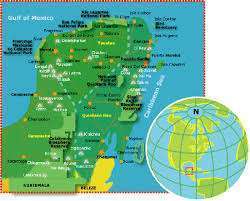What are the Cenotes?
The word “Cenote” comes from the Mayan “D’zonot” and means “well.”
Cenotes are natural pits, or sinkholes, resulting from limestone bedrock collapse, exposing the groundwater underneath. Cenotes are common geological features in low-latitude regions, particularly on islands, coastlines, and platforms with young limestones with little soil development. They spread all over the Yucatán Peninsula of Mexico. The term “cenote” also describes similar karst features in other countries such as Cuba and Australia, in addition to the word “sinkholes.”
Diving into the cenotes is like diving into the history of the peninsula of Yucatan and much more. It gives a wonderful chance to appreciate the evidence of geological changes, archeological discoveries, extinguished species fossils…
The best way to discover the Cenotes will be by cavern diving or cave diving, getting cave diving training.
Cenotes’ Description
Cenotes are the connections to the subterranean water bodies. They can feature large open water pools or small sheltered pools. Sometimes they do not have any exposed water. There are over 6000 different cenotes in the Yucatan Peninsula in Mexico.
Cenote waters are usually crystal clear, as the water comes from rainwater filtering slowly through the limestone. Therefore contains very few particles. For cave divers’ great pleasure, cenotes sometimes reveal an underlying cave system.
The Yucatan Peninsula officially hosts the two longest cave systems globally, Ox Bel Ha and Sac Actun. Thanks to many years of hard work and many hours of exploration, active explorers recently connected Sac Actun (264 km) and Dos Ojos (83km) underwater (January 2018).
Cenotes around the world attract cavern and cave divers.
The Yucatán peninsula

Formed during the Cenozoic era – 65,000,000 years ago, the peninsula of Yucatan is very young. The entire peninsula was once a reef, but as the water level dropped, the flatland of Yucatan emerged.
The peninsula is the exposed portion of the larger Yucatán Platform, composed mostly of limestone. The whole of the Yucatán Peninsula is an unconfined flat lying karst landscape.
The center of the Chicxulub crater is deeply buried off the peninsula’s north coast near the town of Chicxulub. Sixty-five million years ago, a meteorite impacted the greater Caribbean Basin. The famous “Ring of Cenotes” outlines one of the shock waves from this impact, which lies more than 1 km below the modern ground surface.
Although cenotes spread widely throughout much of the Yucatán Peninsula, a higher-density circular alignment of cenotes overlies the ridge of the Chicxulub Crater. This crater structure is identified from the alignment of cenotes, along with geophysical methods.
Limestone

Limestone is a sedimentary rock composed primarily of calcium carbonate (CaCO3) in the mineral calcite. It mostly forms in clear, warm, shallow marine waters. It is an organic sedimentary rock that forms from the accumulation of shell, coral, algal, and fecal debris. It can also be a chemical sedimentary rock formed by the precipitation of calcium carbonate from lake or ocean water.
Dissolution of the limestone, formation of the caves
For the Chemists, this is how it goes:
 Limestone dissolution – Chemical reactions leading to cave formation
Limestone dissolution – Chemical reactions leading to cave formation
Sources: Gunn J. (Ed.) 2003. Encyclopedia of Caves and Karst Science. Routledge. New York
Calcium precipitation in the Cenotes forms a white layer at the surface
Flora and fauna of the Cenotes
Remipede (Speleonectes tulumensis)
Flora and fauna are generally more limited than in the open ocean; however, marine animals prosper in caves. In caverns, one can spot mollies, guppies, catfish, small eels, and turtles. In the darkest cenotes, the fauna has evolved special features to live without natural light. For example, most cave fauna don’t have pigmentation and are often blind. They are equipped with sensors to find food and navigate in the dark.
Remipedes are primitive centipede-like crustaceans. They can grow up to an inch (2.5 cm), using venomous fangs to capture their prey. No other crustacean has this characteristic.Isopod (Metacirolana mayana)
These cave scavengers feed on whatever comes across their claws (usually smaller crustaceans).
Find out more about remipedes with our Youtube video
Mexican Blind Fish (Typhliasina pearsei)
A fish species that inhabit the brackish and freshwater layers of the Yucatan’s caves. The albino, a sightless fish, grows a couple of inches (5 cm). And unlike most other fish, it gives birth to live young.
Check out our blindfish video on our youtube channel.




